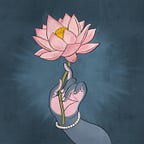The Viewing of the Solar Eclipse at Kurukṣetra
In the tenth skanda of the Bhāgavata purāṇa, after Kṛṣṇa defeated Kaṃsa and embarked on princely adventures with his brother Balarāma, Kṛṣṇa along with all the Yādavas gathered by the water bodies at the sacred pilgrimage site of Syamantapañcaka in Kurukṣetra (in modern-day Haryana) to bathe on the occasion and observe austerities during the solar eclipse. During the eclipse at Kurukṣetra all the Kurus, including Dhṛtarāṣṭra, Yudhiṣṭhira, Bhīṣma and Droṇa, along with the Yādava king Nanda happily shared the company of Śrī Kṛṣṇa.
“On one occasion, while Balarāma and Kṛṣṇa were living in Dvārakā, there occurred a complete eclipse of the sun, just as if had at the time of deluge, when end of Lord Brahmā’s day had come.”
Bhāgavata purāṇa 10.82.1
Long before their time, it was there at Syamantapañcaka that Lord Paraśurāma had done penance at Kurukṣetra to atone for his killings, and caused five ponds to be filled with the blood of kings, while attempting to exterminate all Kṣatriyas from the earth. They were still present at the end of Dvāparayuga, as they are even today. Though the glorious Lord Paraśurāma was untouched by any Karma (despite his punitive actions), in order to set a model example for mankind, he performed a great sacrifice there for the expiation of sin, just as an ordinary person would have had to have done. There at Samanta-pañcaka, the saintly Yādavas, richly adorned and accompanied by their wives, bathed and then observed a fast. Afterward, they presented brāhmaṇas with cows bedecked with garments, flowers and necklaces of gold. After the eclipse had passed, the Vṛṣṇis once again took bath in the pools created by Paraśurāma as per prescribed formalities. They then served delicious food to the brāhmaṇas and prayed, “ May we be blessed with constant devotion to Kṛṣṇa.” Then with the assent of the brāhmaṇas, they broke their fast and took rest under the cool shade of tees.
Ordinarily, the viewing of an eclipse is considered inauspicious and supposed to bring ill omens, yet, this particular eclipse was predicted to bring good fortune to all who witnessed it. This folio depicts the lesser known incident, and is from a manuscript illustrated in the Pahadi region of Kangra, attributed to one of the descendants of the renowned artist of this school, Nainsukh.
References:
The Bhagavata-Purana Part 4: Ancient Indian Tradition and Mythology Volume 10. N.p., Motilal Banarsidass, 2004. All five parts of the translation can be found in full at: https://archive.org/details/BhagavataPuranaMotilalEnglish/
https://asia.si.edu/krishna-and-his-family-admire-a-solar-eclipse/
__________________________________________
If you find value in my work, I hope you consider becoming a patron or making a contribution to hindu.aesthetic@okicici. Hindu Aesthetic requires a lot of time and effort and your support would mean that I can continue bringing you the best possible content. ❤
